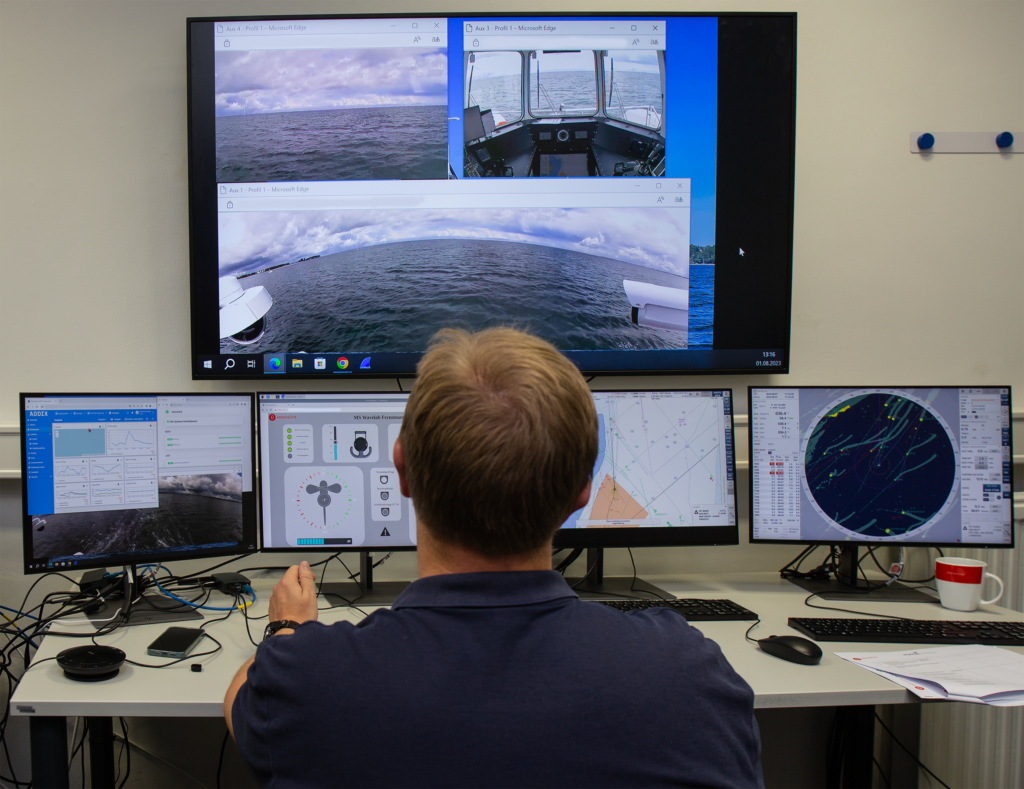CAPTN control center opened
3. August 2023- CAPTN Fjord 5G project reaches another milestone
- Bridge system in Wik monitors voyages of research catamaran MS Wavelab
- Stage 2 in automated and autonomous navigation (according to ZKR) achieved
- Digital twin of ship and test field enables testing of maneuvers and applications for autonomous navigation

With the delivery of the MS Wavelab as a research catamaran for autonomous and semi-autonomous navigation, the research of the Clean Autonomous Public Transportation Network (CAPTN) initiative in Kiel has really taken off. Now the control center for monitoring and remote control of the research vessel has been successfully opened.
During an official test run last Tuesday, Kiel-based company Anschütz, a specialist for navigation and integrated bridge systems, successfully demonstrated the remote control of the MV Wavelab from a control center set up on the company’s premises. The commissioning of this important control center marks another milestone in the Förde 5G and Förde Areal CAPTN research projects.
“We are pleased that with the commissioning of the shore control center at Anschütz we are now taking a major step towards semi-autonomous and autonomous navigation in the digital test field in Kiel,” said Daniel Sommerstedt, CAPTN project manager at Anschütz.
From the control center, the MV Wavelab is monitored in real time cruising at the maritime test site on the inner Kiel fjord. Trained personnel can access the sensors, drives, cameras and navigation systems on board and remotely control the vessel. The project partners are using a digital twin that maps all data from existing and experimental sensors and systems on board in the monitoring center. Daniel Laufs, Innovation Manager of the CAPTN Fjord 5G project located at Kiel Science Center, sees this as a major advantage for the entire CAPTN initiative: “A digital twin not only provides an excellent research and development environment for the various research groups working together within CAPTN, but also opens up entirely new potential for further projects that will bring us a significant step closer to the autonomous passenger ferry of the future.”
With the commissioning of the control center, level 2 of the autonomy scale developed by the Central Commission for Navigation on the Rhine (ZKR) has been reached. This scale has six levels from 0 to 5. Level 2 corresponds to partial automation, i.e. remote control is allowed under certain conditions; the skipper must be able to perform “dynamic navigation tasks” and intervene in case of emergency.
In order to exchange large amounts of data in real time between the control center and the ship, a high-performance maritime data communication infrastructure has been set up along the inner fjord and on land, based on a 5G mobile network and a Wifi6 network from ADDIX GmbH, one of the project partners in the realization of the control center. “For the safety of the people on board, uninterrupted and fast data transmission is crucial,” said ADDIX Managing Director Björn Schwarze. “We will now use the data from the test runs to further optimize the system architecture and precisely coordinate the various fallback levels.
“One of the next steps will be to figure out what information needs to be presented to users in a way that allows them to monitor and remotely control the Wavelab safely and efficiently,” Sommerstedt said. In the long term, the center will serve as a kind of tower for autonomous shipping. Self-propelled vessels will be monitored from here, and trained personnel will be able to intervene and take control in an emergency.
The control center on land is equipped with a large monitor on which camera systems display a 360-degree view in real time. As on the ship, multi-function displays provide access to the navigation radar and the Electronic Chart Display and Information System (ECDIS). A flexible display of navigation data is also provided. Another display serves as a user interface for the MS Wavelab’s control and propulsion systems. A separate dashboard displays and monitors system performance, such as available bandwidth, system component status, and energy management.
“We can very flexibly test additional scenarios such as collision avoidance and other assistance systems in a real, virtual environment and derive from this how we can improve the safety and efficiency of future navigation systems,” said Sommerstedt, describing the project horizon.
Partners in the CAPTN Förde 5G project are the Kiel University, the City of Kiel, Port of Kiel as well as AVL Deutschland, HH Vision, Schlepp- und Fährgesellschaft Kiel mbH and Science Hub Kiel; the associated partner is Wehrtechnische Dienststelle WTD71, whose naval arsenal provides an ideal protected harbor for testing autonomous driving maneuvers.
The CAPTN Förde 5G project is funded by the German Federal Ministry of Digital Affairs and Transport (BMDV) with four million euros.
Translated with the assistance of DeepL & DeepL KI.